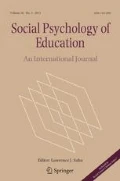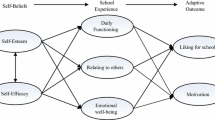Abstract
The purpose of this study is to examine the degree towhich various kinds of out-of-school activitiesadolescents participate in influence their schoolengagement, achievement, and perceptions of their lifechances. The conceptual framework outlined by theauthors suggests personal investments students makeoutside of school in meaningful, structured activitiesand with the help and guidance of adults serving asrole models have significant effects on variouseducational outcomes. To that end, the authors foundsome evidence suggesting that student participation instructured activities and religious activities andtime spent interacting with adults during tenth gradeappear to have positive and significant effects onvarious educational outcomes by Grade 12. Conversely,time spent hanging out with peers was consistentlynegatively associated with educational outcomes in thestudy, with few exceptions. The effects of time spentworking for pay and time spent alone were somewhatinconsistent throughout the analysis but this may bedue to methodological problems within the measures. The result of the analysis has implications forafter-school and summer school policies and programs. The authors discuss these implications and suggestfurther study of the effects of school context, familyinfluence, and the availability of community resourceson students' personal investments.
Similar content being viewed by others
References
Bank, Barbara J. (1997). Peer cultures and their challenges for teaching. In B. J. Biddle, T. L. Good, & I. F. Goodson (Eds.), The international handbook of teachers and teaching (Vol. 3). Dordrecht, The Netherlands: Kluwer Academic Publishers, pp. 879–937.
Biddle, Bruce J., Bank, Barbara J., Anderson, Don S., Keats, John A., & Keats, Daphne M. (1981). The structure of idleness: In-school and dropout adolescent activities in the Unites States and Australia. Sociology of Education, 54, 106–119.
Braddock, Jomills H. III, Royster, Deirdre A., Winfield, Linda F., & Hawkins, Randolph (1991). Bouncing back: Sports and academic resilience among African-American students. Education and Urban Society, 24(1), 113–131.
Carnegie Council on Youth Development (1992). A matter of time: Risk and opportunity in the nonschool hours. New York: Carnegie Corporation of New York.
Conrad, Dan & Hedin, Diane (1989). High school community service: A review of research and programs. Madison, WI: National Center on Effective Secondary Schools.
Csikszentmihalyi, Mihaly & Larson, Reed (1984). Being adolescent: Conflict and growth in the teenage years. New York: Basic Books.
Dryfoos, Joy G. (1990). Adolescents at risk: Prevalence and prevention. New York: Oxford University Press.
Galbo, Joseph J. (1989, April). Nonparental significant adults in adolescents' lives: Literature overview, theory, and issues. Paper presented at the National Biennial Meeting of the Society for Research in Child Development, Kansas City, MO (ERIC Document Reproduction Service No. 305996).
Holland, Alyce & Andre, Thomas (1987). Participation in extracurricular activities in secondary school: What is known, what needs to be known? Review of Educational Research, 57(3), 437–466.
Krug, R. E. Schwarz, P. A., & Bhakdi, S. (1976). Measuring village commitment to development. In H. A. Laswell, D. J. Lerner, & J. E. Montgomery (Eds.), Values in development. Cambridge: Massachusetts Institute of Technology Press, pp. 104–131.
Larson, Reed W. (1983). Adolescents' daily experience with family and friends: Contrasting opportunity systems. Journal of Marriage and the Family, 45(4), 739–750.
MacLeod, Jay (1987). Ain't no making it: Leveled aspirations in a low-income neighborhood. Boulder: Westview.
Maehr, Martin L. (1990). The psychological environment of the school: A focus for school leadership. Urbana, IL: Illinois University, Beckman Institute for Advanced Science and Technology (ERIC Document Reproduction Service No. ED 327 954).
Maehr, Martin L. & Braskamp, Larry A. (1986). The motivation factor: A theory of personal investment. Lexington, MA: Lexington Books.
Mahoney, Joseph L. & Cairns, Robert B. (1997). Do extracurricular activities protect against early school dropout? Developmental Psychology, 33(2), 241–253.
Murray (Nettles), Saundra R & Murray, Charles A. (1979). National evaluation of the PUSH for Excellence Project: Evaluation design. Washington, DC: American Institutes for Research (ERIC Document Reproduction Service No. ED 1777444).
Murray, Saundra R., Murray, Charles A., Rouse, W. Victor, & Kumi, Linda (1980). National evaluation of the PUSH for Excellence Project: Implementation. Washington, DC: American Institutes for Research (ERIC Document Reproduction Service NO. ED 199322).
Nettles, Saundra M. (1989). The role of community involvement in fostering investment behavior in low-income Black adolescents: A theoretical approach. Journal of Adolescent Research, 4, 190–201.
Nettles, Saundra M. (1991a). Community contributions to school outcomes of African-American students. Education and Urban Society, 24(1), 132–147.
Nettles, Saundra M. (1991b). Community involvement and disadvantaged students: A review. Review of Educational Research, 61, 379–406.
O'Brien, Eileen & Rollefson, Mary (1995). Extracurricular participation and student engagement. Washington, DC: Policy Studies Associates, Inc. (ERIC Document Reproduction Services No. 384097).
Rivera, R. & Short, J. (1967). Significant adults, caretakers, and structures of opportunity: An exploratory study. Journal of Research in Crime and Delinquency, 4, 76–97.
Schwartz, Gary (1987). Beyond conformity or rebellion: Youth and authority in America. Chicago: University of Chicago Press.
Smith, Thomas E. (1990). Time and academic achievement. Journal of Youth and Adolescence, 19, 539–558.
Stanton-Salazar, Ricardo D. (1997). A social capital framework for understanding the socialization of racial minority children and youths. Harvard Educational Review, 67(1), 1–40.
Zill, Nicholas, Nord, Christine W., & Loomis, Laura S. (1995). Adolescent time use, risky behavior, and outcomes: An analysis of national data. Rockville, MD: Westat (ERIC Document Reproduction Service No. ED 395052).
Author information
Authors and Affiliations
Rights and permissions
About this article
Cite this article
Jordan, W.J., Murray Nettles, S. How students invest their time outside of school: Effects on school-related outcomes. Social Psychology of Education 3, 217–243 (1999). https://doi.org/10.1023/A:1009655611694
Issue Date:
DOI: https://doi.org/10.1023/A:1009655611694




